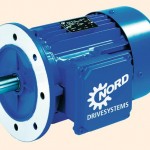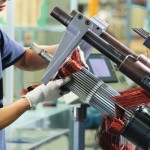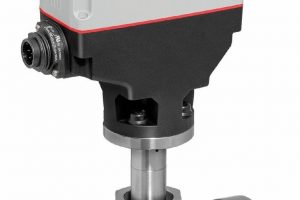The energy saving directive is currently a hot topic, as many mechanical engineering and plant construction companies are intensively considering the subject. Drive manufacturers’ design specialists are therefore heavily involved in providing advice to users, offering information about the new requirements as well as highlighting the advantages of IE2 motors. The benefits of these advantages to users will be explained below.
The author: Jörg Niermann Marketing Manager, Getriebebau Nord
In the context of global efforts for climate protection, the International Electrical Engineering Commission has developed a new standard to harmonise the efficiency classes of electric motors: IEC 60034–30:2008. Throughout Europe, the new standard will be implemented by the so-called Ecological Design Directive ErP 2009/125/EU (the successor to the regulation EuP 2005/32/EU), which came into force on 16 June 2011. Since this date, drive manufacturers may only sell motors with powers of between 0.75 and 375 kW, which are affected by the new directive, in the (more expensive) IE2 version. Mechanical engineering companies are also obliged to use efficiency-optimised motors from this date.
The standard prescribes the use of IE2 motors for all continuous operation applications (S1 operating mode). Exemptions include use with frequency inverters and applications with explosion-protected drives, as well as for brake motors, submerged motors, motors which are used at ambient temperatures above +40 °C or below -15 °C, or motors which are used at altitudes in excess of 1000 m. Existing stocks of motors and replacement drives which have already been installed but do not yet comply with the IE2 standard can also continue to be used after the regulation came into effect.
Operating conditions
IE2 motors are not required for intermittent and short-period operation. On the other hand, continuous operation does not necessarily mean that the motor is in continuous operation throughout the day or throughout a shift. Although this is often the case, if for example, a motor is only required for one hour per day and is switched on and off once, this is also considered to be continuous operation should the motor run continuously during this one hour. Unless there are special circumstances which mean that the application is subject to exemption, conversion may not be worthwhile due to the effort and expense involved.
However, in many industrial chemical applications the applications are used in conventional continuous operation, i. e. at least for several hours at a time – so that the investment in energy-saving IE2 motors quickly pays for itself. These include pumping applications and agitators as well as conveyor systems and conveyor belts. For pumping applications in particular, investment in the new drive generation may be worthwhile, even if the pump drives are controlled by frequency inverters and are therefore actually exempt from the IE2 regulation. According to the viscosity of the medium, high powers are often required, for which IE2 motors provide better reserves. The same applies to agitators, in which for example plastic resins, paints or lacquers are continuously mixed and moved. Finally, it should not be underestimated that high-efficiency IE2 drives have an environmentally friendly image – which many manufacturers can use to achieve their own environmental targets.
Special features
For chemical applications, in addition to improved energy efficiency, IE2 motors offer a whole range of benefits. For one thing, they only produce a small amount of waste heat, which means that the load on the air conditioning plant is reduced. The reduced waste heat is also advantageous in many chemical processing applications, where cooling water released into the environment should not be too hot. In addition, the bearings of IE2 motors are subjected to less thermal stress, so that the service life of the motors is considerably increased. Finally, Nord IE2 motors are designed for a wide range of voltages: due to the use of more active material, voltage fluctuations can be better compensated and the drives can provide higher powers. In addition, Nord also supplies IE2 motors for the special voltage of 290/500 V, which is widespread in the chemical industry. It should also be specially noted that IE2 versions are about 10 to 40 % heavier in comparison with the previous EFF2 versions. In exceptional cases, some of the dimensions deviate from the previous sizes, so users and designers must take this into account during planning.
Three-point concept implemented
Nord Drivesystems has implemented a three-point concept for its energy saving motors, which fulfil the globally valid outline conditions of the IEC standard 60034–30. Efficiency class IE2 is achieved with designs that use more active material and include higher quality sheet metal with lower losses – which increase the copper filling factors while reducing the size of the winding heads. These versions of IE2 motors have been available since the end of 2010. The efficient solutions are superior to earlier models in many respects: As well as higher efficiency, they also have higher starting and breakdown torques, less slip, as well as less waste heat and thermal reserves. Therefore, in comparison with its direct predecessor, an IE2 model has a longer service life and a greater potential for saving operating costs.
Nord IE2 motors have new characteristics. Thermal reserves enable a new design of the drive units, with which the partial load range can be shifted upwards. Thanks to pseudo symmetrisation of the rating point, efficient operation is also possible above the rating point. The lower losses of IE2 motors allow operation above the rated power, which is also not thermally critical in continuous use. For users this means that this operating range can also be included in sizing the motor for the application. As the start-up and breakdown torque has also been increased, Nord recommends that the design is optimised and safety factors are reduced or removed entirely, as the motor has permanent reserves. If these reserves are consistently utilised, economic benefits result, as in many cases smaller sizes may be used. For motors with several rated voltages, the regulation requires that the efficiency for the most unfavourable measurement point is stated. Nord 4-pole IE2 motors have sufficient reserves for them to continue to be supplied for the wide voltage range.
Online-Info: www.cpp-net.com/2211434
Share:








